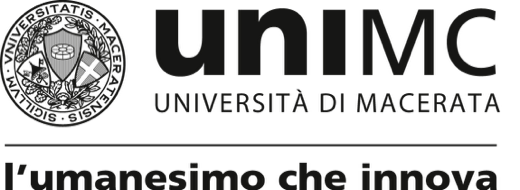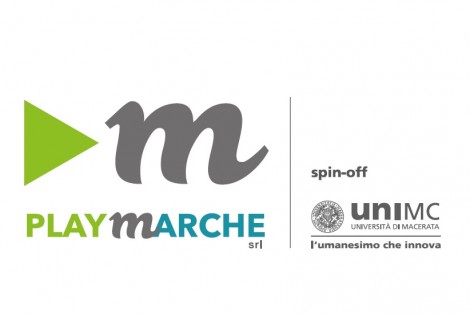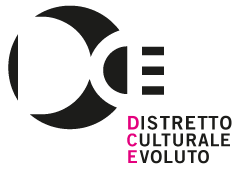Nel giugno del 1967 la Soprintendenza Archeologica delle Marche, su segnalazione del prof. Valeriano Trubbiani, recuperò nell’alveo del fiume Potenza 150 blocchi di pietra, per la maggior parte in calcare che emergevano sulla sponda destra del fiume vicino alla cava di sabbia a 300 metri ad Ovest del moderno ponte che collega le due parti dell’attuale abitato di Villa Potenza, reimpiegati per creare un argine del fiume.
Per la presenza di figurazioni a rilievo, di elementi architettonici e di iscrizioni, al momento del recupero fu subito chiaro che si trattava di blocchi pertinenti a opere di carattere monumentale di età romana successivamente collocati nell’area del teatro romano; alcuni di essi vennero ricomposti in unità monumentali utilizzando come criterio la congruità dal punto di vista architettonico, l’identità di materiale e di stile.
Alla luce dello studio realizzato sui blocchi, si ipotizza che parte del materiale fosse originariamente pertinente a monumenti funerari. Nello specifico i blocchi in questione sono stati ricondotti a quattro tipologie monumentali: monumento a monoptero su podio; edicola prostila su podio; edicola periptera su podio; sepolcro a recinto. Ad essi si aggiungono due blocchi di trabeazione pertinenti con molta probabilità ad un’unica edicola funeraria il cui fregio presenta una decorazione a girali e foglie d’acanto.
Si tratta di tipologie funerarie legate all’ascesa di élites locali che si rappresentavano attraverso l’ostentazione della monumentalità dei loro sepolcri.
The funerary monuments
In June 1967 the Archeological Superintendence of Marche, on the recommendation of Professor Valeriano Trubbiani, collected 150 blocks of stones from the course of the river. Most of them are limestone blocks emerging on the right bank of the river, close to the sand cave located 300 m west of the modern bridge connecting the two parts of the town Villa Potenza. They were reused to build a bank of the river itself.
The presence of relief figures, of architectural elements and inscriptions made it clear that they were blocks belonging to some monumental building dating back to the Roman period and later put in the area of the Roman theatre; some of them were reassembled in monumental units following the principle of congruity as far as architecture, material and style are concerned.
After some studies on the blocks, it was established that part of the material had originally belonged to funerary monuments. Specifically, the blocks have been related to four different types of monuments: monopteros on podium, prostyle aedicula on podium, peripteral aedicula on podium, enclosed sepulcher. Two more blocks of trabeation belonging to one funerary aedicula deserve to be mentioned, whose frieze is decorated with scrolls and acanthus leaves.
These funerary monuments are to be linked to the ascent of local elites willing to show their prestige through the monumentality of their sepulchers.
Fregio di edicola funeraria
Due frammenti ricomponibili in calcare oolitico appartenenti ad un monumento funerario; sulla faccia superiore si notano i segni della grappa che univa i due blocchi. Il fregio è racchiuso superiormente e inferiormente tra due listelli. La decorazione è costituita da girali, che si svolgono ad andamento ad onda, e foglie d’acanto. Entro le volute sono racchiuse da destra: una rosetta a otto petali, un grappolo d’uva e un bocciolo. Nel blocco di sinistra, dove la decorazione continua oltre l’angolo, è raffigurato un putto in posizione frontale e un erote.
Per il tipo di materiale, per la decorazione e per le dimensioni si ipotizza che questi frammenti possano far parte dello stesso monumento del fregio a sinistra, probabilmente un’edicola.
L’analisi stilistica e i motivi decorativi consentono di datare il fregio tra la fine della repubblica e gli inizi dell’età augustea.
Frieze of a funerary aedicula
Two reassembled oolitic limestone fragments belonging to a funerary monument. Marks of the bracket jointing the two blocks are visible on the front surface. The frieze is enclosed between two slats at the top and bottom. The decoration consists of scrolls in waving bands and acanthus leaves. The volutes include (from right to left): an eight-petal rosette, a bunch of grapes and a bud. On the left block, where the decoration continues past the corner, there is a frontal putto and the erotes.
Due to the material, decoration and dimensions, it is generally agreed that these fragments belong to the same monument on the left, probably an aedicula.
The analysis of the style and decorative patterns allows to date the frieze between the end of the Republican era and the beginning of the Augustan era.
Fregio di edicola funeraria
Due frammenti ricomponibili in calcare oolitico appartenenti ad un monumento funerario. Sulla faccia superiore del blocco a destra si nota la cavità per l’alloggiamento della grappa, in quello di sinistra è ancora presente una parte della grappa in ferro. Il fregio è costituito da una decorazione a girali e foglie d’acanto che si svolge su uno specchio tra due cornici, quella superiore semplice, quella inferiore costituita da un listello e da una gola. Il cespo d’acanto, che si sviluppava specularmente sui due lati e che doveva rappresentare il nucleo centrale della decorazione, si trova nell’estremità destra. La parte di sinistra conserva tre girali diversi, dove nella parte terminale del blocco forma un viticcio con foglia di vite e grappoli d’uva.
Per il tipo di materiale, per la decorazione e per le dimensioni si ipotizza che questi frammenti possano far parte dello stesso monumento del fregio a sinistra, probabilmente un’edicola.
L’analisi stilistica e i motivi decorativi consentono di datare il fregio tra la fine della repubblica e gli inizi dell’età augustea.
Frieze of funerary aedicula
Two reassembled oolitic limestone fragments belonging to a funerary monument. On the top surface of the right block there is a hole housing the bracket, while on the left one, part of the iron bracket is still present. The frieze consists of a scroll-like decoration with acanthus leaves on a mirror between two frames, the plain one on top, the one at the bottom including a slat and a cyma moulding. The head of acanthus, which unfolded in a specular way on both sides and was meant to be the core of the decoration itself, is visible on the right end. The left side preserves three different scrolls, which form a tendril with grape leaves and bunches in the final section.
Due to the material, decoration and dimensions, it is generally agreed that these fragments belong to the same monument of frieze on the left, probably an aedicula.
The analysis of the style and decorative patterns allows to date the frieze between the end of the Republican era and the beginning of the Augustan era.
Edicola periptera su podio
Fondamentali per la ricostruzione di questo monumento funerario sono quattro blocchi, realizzati in un marmo proveniente dal Mar di Marmara detto proconnesio, i quali restituiscono l’intera trabeazione. La sua ricomposizione è stata possibile grazie alla presenza di quattro coppie delle prime lettere dell’alfabeto greco, disposte in corrispondenza dei giunti che servivano al montaggio. L’architrave è formato da due fasce, separate da un tondino intagliato nella forma di un nastro ritorto, e termina con una gola rovescia decorata da un kyma lesbico. Il fregio è costituito da un toro schiacciato, ricoperto da foglie d’alloro racchiuse tra due listelli.
Utili alla ricostruzione del monumento sono stati anche altri blocchi rinvenuti nell’alveo del Potenza: si segnala a tal proposito un grosso frammento di marmo proconnesio che conserva parte di un lacunare e altri blocchi che apparterrebbero al podio del monumento funerario. In merito alla tipologia monumentale, si è ipotizzato che il progetto avesse dovuto comportare un podio quadrato sul quale doveva sorgere un’edicola aperta e sostenuta da quattro colonne agli angoli.
Il monumento ricinense presenta degli elementi che lo avvicinano agli ambienti dell’Asia Minore e della Siria. Nello specifico, tale tipologia monumentale trova dei confronti con una classe documentata nel II secolo d.C. in Asia Minore, vicinanza riscontrabile anche nel tipo di marmo impiegato e nella presenza di lettere greche, un segnale, quest’ultimo, che il monumento in questione fosse stato affidato a maestranze di lingua greca. Inoltre, alla luce del confronto con edifici asiatici, si pensa che l’edicola dovesse presentare una copertura piramidale a gradoni.
La realizzazione del monumento non fu però mai condotta a termine. Difatti sia i blocchi della trabeazione, sia quelli pertinenti al podio, presentando una lavorazione incompleta, subirono la medesima sorte del blocco con lavorazione interrotta proveniente dal teatro.
La costruzione dell’edicola va inserita nel solco del programma edilizio di età severiana successivo alla costituzione della colonia di Helvia Ricina Pertinax.
Peripteral aedicula on podium
The four blocks made of marble from the Marmara Sea, also called proconnesian marble, are fundamental for the reconstruction of the funerary monument, as they recreate the whole trabeation. The reconstruction itself has been possible thanks to the presence of four couples of the first letters in the Greek alphabet, placed in correspondence of the joints needed for the assembly. The architrave consists of two bands, separated by a small, twisted ribbon-shaped circle ending with a cyma reversa moulding, and decorated with a kyma lesbico. The frieze shows a squashed bull, covered by bay tree leaves, held together by two slats.
Other blocks discovered along the course of the Potenza river have been likewise useful: among them, there is a big fragment of proconnesian marble preserving a section of a coffer and other blocks apparently belonging to the podium of the funerary monument. Regarding the monumental typology, it is generally assumed that the project would rely on a square podium as the basis for an open aedicula, supported by four pillars at the corners.
The monument has several characteristics reminding of Asia Minor and Syria; specifically, this monumental typology can be compared to a class documented in the second century A.D. in Asia Minor. Such a similarity is further testified by the marble used, as well as the presence of Greek letters. They represent a clear proof that the monument here discussed had been commissioned to the Greek workforce. In light of the comparison with other Asian buildings, it is believed that the aedicula used to have a terraced pyramid covering.
The structure, however, was never completed. As a matter of fact, both the blocks of the entablature and those of the podium, whose works remained incomplete, suffered the same fate as the unfinished block belonging to the theatre.
The construction of the aedicula is to be regarded as part of the urban renewal commissioned by the emperor Severus, following the institution of the colony of Helvia Ricina Pertinax.
Monumento a monoptero su podio
Il frammento, in calcare oolitico, costituisce parte di un fregio continuo il cui diametro può ricostruirsi in m 2,50; si conserva parte della decorazione centrale, che ritrae una testa taurina. Il confronto con altri elementi architettonici rinvenuti contestualmente nell’alveo del Potenza, alcuni dei quali appartenenti ad una cornice di coronamento, hanno permesso di ipotizzare la loro pertinenza ad un monumento funerario costituito da un monoptero (circolare) su podio, tipologia diffusa anche a Pompei, Ostia, Aquileia, Sestino e in alcune località del Picenum. A livello ipotetico, il monumento si sviluppava per sovrapposizione di più corpi: quello inferiore era rettilineo e chiuso in alto da una cornice, quello superiore aveva forma circolare.
Per il tipo di decorazione il monumento è inquadrabile negli ultimi decenni della repubblica.
Monopteros-shaped monument on podium
The fragment of oolitic limestone is part of a continuous frieze, whose diameter measures 2.50m; a section of the central decoration is still preserved, portraying the head of a bull. The comparison with other architectural elements discovered along the course of the Potenza river, some of which belong to a crowning decorative moulding, allows the hypothesis of a connection with a funerary monument consisting of a (circular) monopteros on podium, a very common typology in Pompei, Ostia, Aquileia, Sestino e some other places in the Piceno area. Probably, the monument developed through the layering of various sections: the lower one was straight and delimited by a cornice on top, while the upper one had a circular shape.
Due to the type of decoration, the monument can be dated to the last decades of the Republic.
Fregio di monumento funerario
Frammento di un blocco in calcare oolitico di cui resta solo una parte del fregio, che presenta una decorazione a festoni con una testa taurina e una maschera di eroina tragica femminile. Il tipo di fregio presenta affinità con quello dell’edicola prostila su podio, tuttavia se ne discosta per una lavorazione più fine e raffinata. Lo stile e il repertorio figurativo datano il frammento tra la fine del I secolo a.C. e gli inizi del I secolo d.C.
Frieze of funerary monument
Fragment of a block of oolitic limestone of which only a section of the frieze is preserved. It has a festoon decoration including a bull’s head and a mask of tragic heroine. The typology of frieze shares some similarities with the one of the prostyle aedicula on podium; however, what differentiates the two friezes is a far finer and more elegant working. The style and the figurative repertoire allow to date the fragment between the first century B.C. and the beginning of the first century A.D.
Edicola prostila su podio
A questa edicola funeraria sono riconducibili tredici pezzi architettonici in calcare oolitico che hanno permesso la ricostruzione di parte dell’architrave e della copertura del monumento.
Dell’architrave si conservano quattro blocchi, la cui unione è stata facilitata dalla presenza delle cavità per l’alloggiamento delle grappe, che si conservano sul piano superiore. La ricostruzione della trabeazione è stata possibile anche grazie al tipo di decorazione, che accomuna i blocchi in questione. Quest’ultimi presentano un fregio ornato a festoni sorretti da teste taurine; entro i festoni si susseguono maschere di tipo teatrale. Si sottolinea che il fregio presenta delle analogie con quello del blocco con la maschera di eroina tragica sebbene sia di fattura meno ricercata. La tipologia è di carattere popolare, che doveva essere facilmente comprensibile e leggibile.
Alla copertura sono invece riconducibili sei blocchi, pertinenti a una cornice e a un soffitto piano decorato a cassettoni. I lacunari consistevano in riquadri con cornici formate da un listello piatto, lo specchio era decorato da fiori a rosone.
Dell’edicola si conserva inoltre la metà destra del frontone in cui figura al centro la testa di Medusa secondo il motivo del gorgoneion, particolarmente diffuso nel coronamento dei monumenti funerari; nell’angolo destro vi è uno scudo rotondo e un gladium.
Non era raro che strutture simili fossero dotate di podii affinché si potessero mettere più in mostra le immagini dei defunti, tuttavia fra il materiale rinvenuto nell’alveo del Potenza non è stato possibile riconoscere dei blocchi che potessero costituire il basamento dell’edicola funeraria.
Sulla base dei blocchi conservati, la pianta che si è potuta ricostruire per il monumento è quella di un’edicola distila prostila in facciata (con due colonne sulla facciata) con parete piena sul lato di fondo e su parte di quelle laterali.
Per la tipologia architettonica e il motivo della decorazione l’edicola si colloca cronologicamente nel periodo compreso tra la fine della repubblica e l’età augustea.
Prostyle aedicula on podium
Thirteen architectural pieces of oolitic limestone belonging to this funerary aedicula, allowed the partial reconstruction of the architrave and coverings of the monument.
At present, the architrave consists of four blocks which have been jointed thanks to the holes housing the brakes/braces preserved on the upper floor. The assembly of the entablature has been possible thanks to the type of decoration that all the blocks share. These show a frieze with festoon-shaped decoration supported by bulls’ heads; the festoons contain theatrical masks. It is also worth mentioning that the frieze shares some similarities with the one of the block representing the mask of tragic heroine, despite its less sophisticated quality. The typology is clearly popular, as it had to be easily readable and understandable.
Six blocks are to be associated with the covering: they belong to a frame and a flat coffered ceiling. The coffers consisted in squares with frames made of a flat slat, while the mirror was decorated with rosettes with flower decoration.
The right half of the pediment is preserved as well, representing Medusa’s head according to the gorgoneion motif, which was widely used in the crowding element of funerary monuments; at the right corner there is a rounded shield and a gladium.
Such structures often consisted of pedestals showing the images of the deceased; however, among the materials discovered along the course of the Potenza river, no blocks have been classified as being part of the base of the funerary aedicula.
Based on the preserved blocks, the map of the monument has been classified as typical of a distyle prostyle in antis aedicula (with two columns on the front), with a solid wall on the back and part of the side walls.
Due to its architectural typology and decoration, this aedicula can be dated to the years between the end of the Republic and the Augustan Age.
Frammento di soffitto piano a cassettoni
Il frammento è appartenente al soffitto decorato a cassettoni dell’edicola funeraria prostila su podio. Il blocco conserva un fiore a rosone quasi completo e l’inizio di un secondo con una rosetta a petali sottolineati da una leggera cordonatura.
Slab of a flat and coffered ceiling
A slab of a flat and coffered ceiling belonging to the prostyle aedicula on podium. The block preserves one rosette with flower decoration almost complete and the beginning of a second with a petal rosette underlined by a slight crease.






